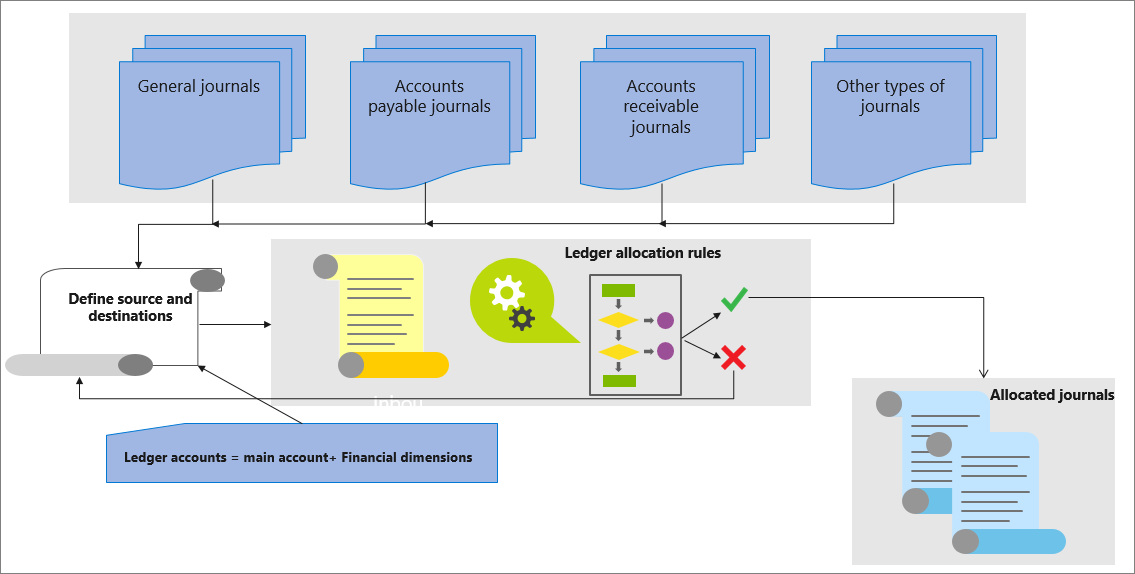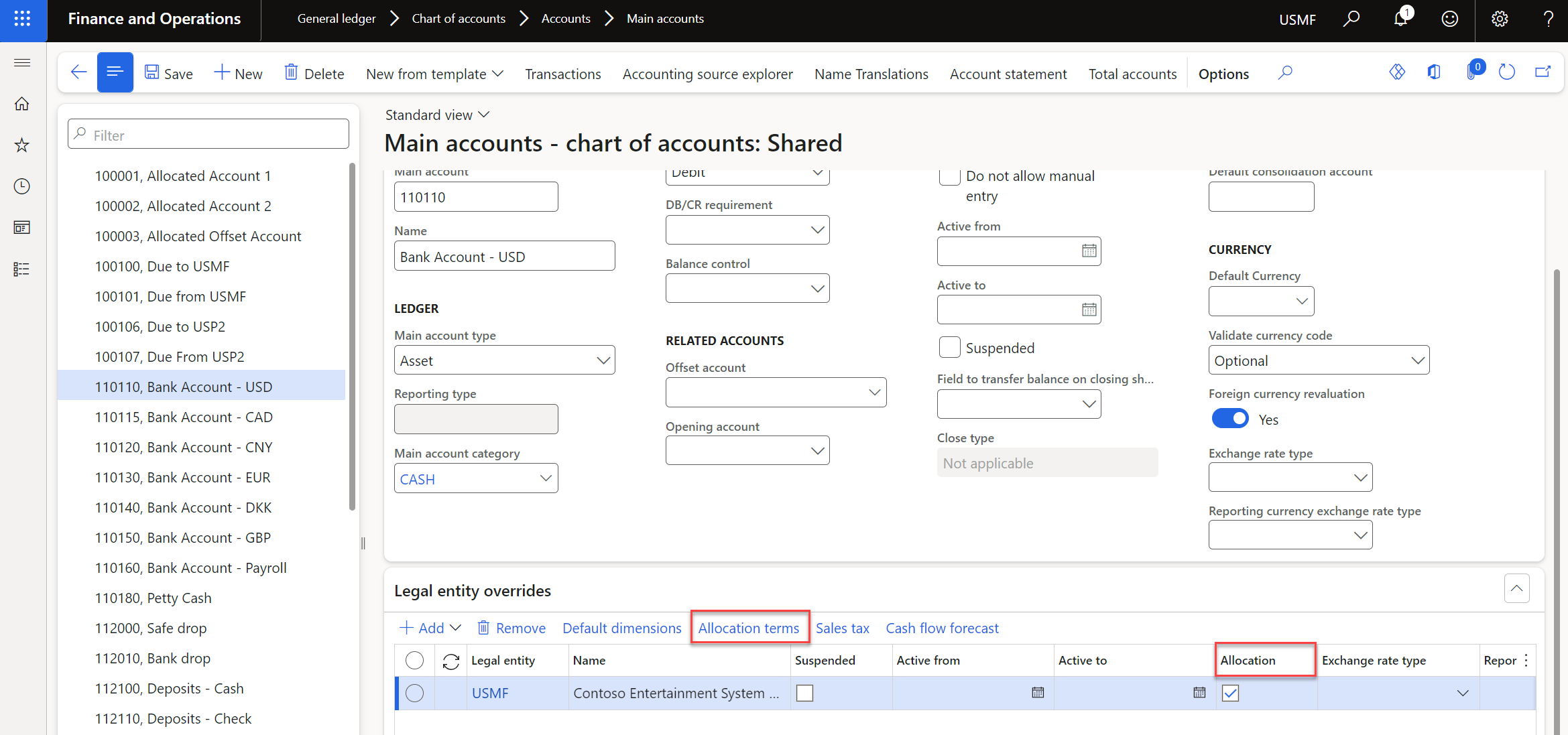Configure ledger allocation rules
Allocation is the process of distributing monetary amounts to one or more ledger accounts. Ledger account is the term used in Finance that consists of the main account plus financial dimensions, which could be blank. Ledger allocations can be performed using one of the following methods:
- Defined on the main account. When a transaction is posted to this main account, the allocation will occur as part of the posting process.
- Defined to run as a periodic process. For example, you can create rules to allocate balances at the end of a month.
Main account allocation terms
If you go to General ledger > Chart of accounts > Accounts > Main accounts page, under the Legal entity overrides FastTab, there is an Allocation check box. Select this option to allocate transactions, based on the allocation terms, when the transactions are posted to this account number. An allocation is automatically processed by using the settings on the Allocation rule page.
Use the Allocation terms button to configure the allocation of transactions posted in this account, based on the legal entity that shares the same chart of account.
Ledger allocation rules
Finance can use predefined allocation rules to perform generated allocations. Generated allocation is the distribution of posted or fixed amounts to combinations of destination accounts and dimensions at any time, which generate new journal entries.
By using the Ledger allocation rules page, you can create rules to periodically process ledger allocations for each rule.
Ledger allocation rules can also be used for budget plans. When you use ledger allocation rules in budget planning, the allocation rules work the same way they would in the ledger, but the source data and destination data come from the budget plan. Unlike the other general ledger journals, you can’t use intercompany ledger allocation rules for budget planning.
You can manually select ledger allocation rules to use for budget plans. Alternatively, you can use an allocation schedule that runs as part of a workflow process.
For more information about budget planning, see Configure and use budget planning in Dynamics 365 Finance.
An overview of ledger allocation process is illustrated below.

Components of ledger allocation rules
Each allocation rule has four components: general, source, destination, and offset. An additional component, ledger allocation basis rules, is required if Basis is used as the allocation method. Each component provides a critical piece of the information that is required to process allocations.
General – This component is where the user specifies options such as the allocation method, intercompany rule settings, and whether the rule is active.
Source – This component is where the user specifies the source data for the allocation. Allocation can be based on ledger balances (Data source = Ledger) or fixed amounts (Data source = Fixed value). When Data source is set to Ledger, source filter criteria must be defined for the ledger allocation rule (for example, for the advertising expenses).
Destination – This component defines to which ledger account the amount will be allocated. For example, an expense can be allocated to each department by creating a destination line for each department value.
Offset – This component defines the ledger accounts used as the offset entries to balance the destination entries. User-defined options are typically used instead of accounts and dimensions that are based on the source. When Data source is set to Fixed value, Source can't be used as an option.
Ledger allocation basis rules – These rules use their own source filter criteria to determine which ledger balances should be used for allocation (for example, the revenue per department). Each allocation basis rule can be used with multiple allocation rules.
The default setting is Source, meaning that entries will be posted to reduce the balances of the Source accounts. If you choose User Defined, the Source account amounts will not be reduced – instead, the Source accounts amounts will stay the same, and amounts will post to the offset account rather than reducing the Source account balances.
For example, for a selected offset ledger account, to allocate only the amounts in the main account that do not have a value for a specific financial dimension, you must add a line with that financial dimension specified to have a blank value, as shown above. If you specify only the main account on the source without a financial dimension filter, all account combinations for that main account will get allocated.
Ledger allocation methods
Ledger allocation rules are used to automatically calculate and generate allocation journals and account entries for the allocation of ledger balances or fixed amounts. Allocation methods can be variable or fixed. The following allocation methods can be used for ledger allocation rules:
- Basis – This variable method is used when the allocation depends on the actual ledger balance, based on filter criteria. For example, advertising expenses can be allocated based on each department's sales in proportion to the total departmental sales.
- Fixed percentage and Fixed weight – For these methods, the allocation percentage or weight is defined directly for the rule. For example, advertising expenses can be allocated so that Department A receives 70 percent of the advertising expense and Department B receives 30 percent.
- Equally – This method distributes the amount equally to each defined destination. For example, if destinations are defined for Department A and Department B, advertising expenses can be allocated so that both Department A and Department B receive 50 percent of the advertising expense.
General ledger > Allocations > Ledger allocation rules > Select line > General tab
The Date interval code filters all posted transactions based on the date range to be selected for the rule.
If Basis is used as the allocation method for an allocation rule, you also need to define separate ledger allocation basis rules.
Process allocation request
The Process allocation request process lets you process the ledger allocation rule and preview the resulting allocation journal entries before you post or delete the calculated allocations.
The As of Date is very important when the Ledger is the Data source for the rule. This date controls which ledger balances to include for allocation.
Use the Zero source drop-down menu to select whether to Process or Stop the request if the source amounts are zero.
Use the Process allocation request page to create an allocation journal that can be reviewed and approved before posting to General ledger by setting the Proposal options to Proposal only. You can post directly to General ledger by setting the Proposal options to Post only. When selecting this option, there is no preview of the accounting entries that will post as a result of running the allocation rule.
Note that there are certain roles that can edit the allocation journal prior to posting.
Watch the following video to see the Allocation rules setup and Process allocation request process.



